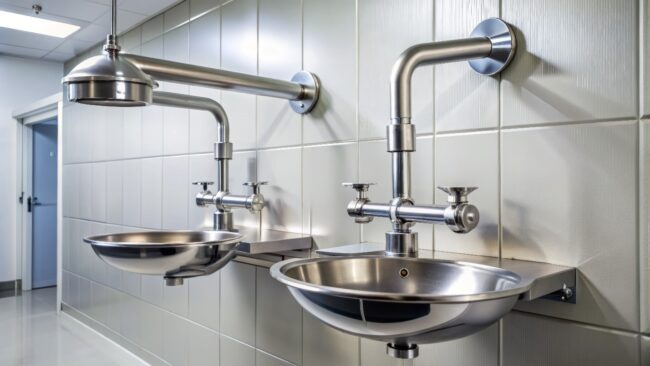In fast-paced industrial environments, safety is a priority that cannot be overlooked. Having the right safety measures can mean the difference between a minor mishap and a life-altering injury. In settings where hazardous materials are present, such as chemicals, debris, or extreme heat, Global Industrial Port Washington reviews how it is essential to provide workers with immediate access to first aid equipment. Among the most critical safety features are eyewash stations and emergency showers, which can help prevent severe injuries, including vision loss and skin damage.
The Vital Role of Eyewash Stations and Emergency Showers
Eyewash stations and emergency showers are crucial in workplaces that handle dangerous substances. These stations provide immediate first aid by flushing away harmful chemicals, debris, or irritants from a worker’s eyes or body. Quick access to these facilities can significantly reduce the severity of injuries, making them indispensable in industrial environments.
Eye injuries, in particular, are common in workplaces, with nearly 20,000 incidents reported annually by the U.S. Bureau of Labor Statistics. These injuries range from minor eye strain to permanent vision damage. Many could be avoided or minimized if an eyewash station was readily available. Similarly, exposure to corrosive substances can cause severe skin injuries, and emergency showers can provide critical first aid to minimize damage.
OSHA Compliance: A Non-Negotiable Requirement
Ensuring that eyewash stations and emergency showers are available in hazardous work environments is not just a good practice—it is a legal requirement. The Occupational Safety and Health Administration (OSHA) has specific regulations regarding the presence and maintenance of these safety systems. According to OSHA’s standard 29 CFR 1910.151(c), workplaces must have suitable facilities for quickly drenching or flushing the eyes and body in areas where employees may be exposed to corrosive materials.
Simply having the equipment installed is not enough. OSHA compliance also requires that these stations be regularly maintained and fully operational. The stations must be capable of delivering a continuous flow of clean water for at least 15 minutes to provide sufficient first aid while waiting for professional medical help. Failure to comply with these regulations can result in hefty fines and, more importantly, put workers at serious risk.
Best Practices for Installation and Maintenance
To ensure that eyewash stations and emergency showers are ready for use when needed, employers must follow best practices regarding their placement, visibility, water temperature, and maintenance.
- Accessibility: OSHA requires that eyewash stations and emergency showers be located within a 10-second reach of any area where hazardous materials are present. This equates to roughly 55 feet. In emergencies involving corrosive substances, seconds can be critical, so placing stations close to hazardous areas without obstacles is essential.
- Visibility: Eyewash stations and emergency showers should be easy to locate, even in chaotic or low-visibility situations. Using clear signage with bright, reflective colors helps ensure the stations are easy to spot. Additionally, positioning them in well-lit areas improves their visibility during emergencies.
- Water Temperature: The water in eyewash stations should be tepid, ideally between 60°F and 100°F (16°C and 38°C). Water that is too cold can cause shock, deterring workers from using it for the full recommended 15 minutes. Conversely, water that is too hot can cause additional injury. Tepid water ensures the comfort and safety of the worker, encouraging proper use.
- Routine Maintenance: Regular inspections and maintenance are vital for keeping safety equipment functional. Weekly checks should verify that water flows correctly, the temperature is within the recommended range, and the equipment is free from blockages or other issues. Monthly and annual testing should ensure that all components are working properly and that the water supply is clean and uncontaminated.
Training Employees for Emergency Situations
Even with the best equipment in place, it is critical that employees know how to use eyewash stations and emergency showers properly. Regular training sessions and emergency drills should be conducted to familiarize workers with the locations and operation of these stations. Training should also educate employees on the potential hazards they face and the appropriate first aid responses in case of exposure.
Selecting the Right Equipment for Your Workplace
Choosing the appropriate eyewash station or emergency shower depends on the specific needs of your workplace. It is essential to select equipment that meets the demands of your environment and complies with OSHA regulations.
- Combination Units: In environments with multiple hazards, combination units that offer both an emergency shower and an eyewash station can provide comprehensive protection. For instance, stainless steel units are durable and resistant to corrosion, making them ideal for harsh industrial settings.
- Portable Eyewash Stations: For worksites without access to a plumbed water supply, portable eyewash stations are a practical solution. These units are easy to transport and can be placed wherever they are needed, ensuring that no hazardous area is left unprotected.
A Commitment to Workplace Safety
With thousands of workplace injuries occurring annually, the importance of having properly installed and maintained safety equipment, such as eyewash stations and emergency showers, cannot be overstated. These critical tools not only help prevent serious injuries but also protect the health and safety of workers. By investing in high-quality, compliant solutions and providing proper training, employers can create a safer work environment where employees can focus on their tasks without unnecessary risk. In the end, when it comes to workplace safety, every second counts.
